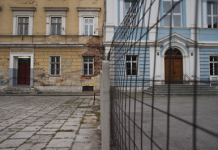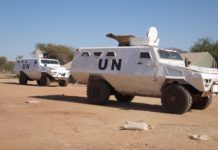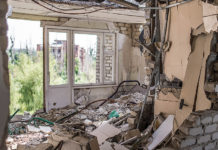Haiti, on January 12th of 2010, in the beginning of the evening, the ground shakes: then the country is gripped by panic, covered in dust, people are looking for survivors, and among them, the injured are crying out in pain, trying to find someone to help them. The fears of the living. The screams of the survivors calling for help and getting weaker. And, after a night and a day in a state of shock, people discover damages and colors of a blood city with casualties, corpses and tears.
Right after the earthquake, wounded inhabitants realized the scale of the disaster. A scary and oppressive awareness: the earthquake killed a lot of people, and dead bodies were everywhere: under piles of rubble or already placed on the streets, they were very close. Familiar or unknown dead bodies.
Although the living didn’t know where to go, trying to find out if their relatives were fine or not and the human and material reports confirmed their fears, an important question was asked: what are we going to do with all these bodies?
Very quickly, Haitians wanted to hide dead corpses. Not only because when they look at them, they think about their own death and the numerous beliefs relating to it. Not only because it’s unbearable to be confronted with absolute disaster when life tries to go back to normal again. But also because in the first days of the uproar, the living and the dead were in the same situation: in the street, homeless, shameless. And above all, in addition of morbid fears, because death is everywhere with concrete consequences: smells, excreta, distortions. When the person we talked with yesterday is now just a piece of flesh but not a skeleton yet: when he is more organic than mineral. Between these two steps, the corpse is in a state of decay, fastened by the rays of the sun of this tropical island.
So, it was necessary to do something. Not burning bodies on piles of rubbish as it was done in some scattered regions, but putting them away of people to make a distance between them and us, between the death and the life. Sewing together flour bags to put children in them. Using pieces of material or boxes which were not useful for the living to hide faces. Soon, gathering corpses in warehouses to be collected by the terrible but inexorable travel towards mass graves.
Some, who have found the body of close relations, buried them near their ruined house, under hills, or along roads. Now, cities ravaged by the earthquake look like huge cemeteries slowing down the reconstruction, each grave disturbing renovation works. Others, who didn’t want to take the risk of burying their families in that way and refusing mass graves, had to practice cremation, an extreme difficulty in a country which doesn’t use that kind of method. The richest rented cars to bury their relatives in close cities; but the poorest were brought in big graves. Most of the time, the living tried to restore dignity to the dead people and satisfy them by doing some gestures or saying some ritual words in order to help their spirit to keep living. Thus, in emergency, people looked after the dead with the little they have, by organizing themselves or by following the improvised ballet of trucks which brought corpses in graves.
And then, Haitians had to face up to things: because there are realities which are more significant than dead bodies and scarify the living souls. Thus, smells and fetid emanations emerged during some weeks after, when a body was discovered from ruins. Images of piles of dead bodies, heaped up in a mess, without the respect of their dignity, without decency nor pretence, without the veneer of culture that all societies use to stand aloof from horror. And flies.
Flies, after the earthquake, were happy. Because these animals are necrophagous: they take an active part in the decomposition process which, in usual times, disgust as well as being a life-saver because that helps to make disappear physiological scraps. But humans decided to adopt the cultural rule of avoiding the confrontation between human bodies and nature.
And flies fly. From a dead body to a living being. They eat the dead and used to land on the living’s hands. They don’t respect any boundary, they are invasive and they enter houses without distinction nor consideration. And they reproduce themselves very quickly and voraciously: Port au Prince was soon flown over by swarms, annoyed when they were bothered. This scourge causes an unceasing buzzings of millions of flies which eat dead bodies until they die of indigestion. Swirling flies, flies dying suddenly, feeling sick of so much decay.
Haitians as well as expatriates or rescue teams who came to find survivors were profoundly shocked by these animals. These scenes stood out in Haitians memories, engraved by intangible rifts sometimes more important than body injuries: these scenes are uppermost in their minds, details which still haunting nowadays the Haitians nights. Such images strike souls, upset the senses and make sick: nausea, vertigo, vomiting, and nightmare. In the « reconstruction » of Haiti, souls need to be exorcized as bodies have to be repaired and building to be reconstructed. But, for now, these souls are only comforted by religious groups. And the NGOs, often helping in psychological traumas too, meet with a popular fear between patients and psychologists: indeed, these spirit doctors are often associated by Haitians ‘imagination with black magic people and they are afraid of them. Besides, it is often difficult to accept this psychological work for those who have to build their daily life after the tragedy and who get back very quickly their “normal” rhythm to ensure their survival. People of the international community who stayed in Haiti, also fear a little to go and see a psychologist: the fragility of the relationship between expatriates makes the possibility of confiding in someone harder because they don’t find people perfectly biased easily, out of their network.
Thus, in areas in which the international community intervenes, where humanitarian assistance is mobilized, the death and the dead issue, even if it’s a taboo subject and not a priority (we focus on the living), is crucial: because dead people are not invisible, they need a logistic know-how facilitating their picking up; and their psychological, moral and historical effects have to be considered in the long-term. Besides, a political aspect is connected to this issue: the recognition of casualties through the construction of a memorial for example. Shouldn’t be a mark of respect towards dead people? Or a way of reintroducing them in the national tragedy of Haiti history? Or even, a strategy involving the politics involvement in the construction of a State and a national identity?
Translation : Morgane Chatel
Alice Corbet
Derniers articles parAlice Corbet (voir tous)
- L’action humanitaire à l’épreuve des risques du terrain : quelques réflexions à partir du cas haïtien – 29 novembre 2013
- Le kouraj d’être soi en Haïti – 15 septembre 2013
- Jerry, le graffeur qui fait parler les murs d’Haïti – 15 septembre 2013







